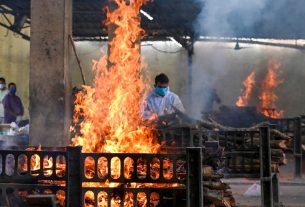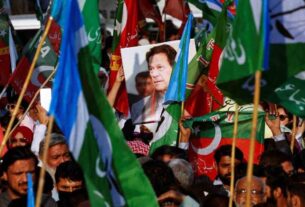Indian government takes number of measures to revive growth, but experts predict slow growth for next fiscal year
The Indian economy has run into a rough patch, with growth dipping to the 5% level in the year’s second quarter — the lowest over the last six years.
With a 3% year-on-year drop, the latest falter has led to job cuts, holds on fresh hiring, rise in unemployment, factory shutdowns, and suspension of production.
Annual GDP growth slumped to 6.8% in 2018-19 fiscal year from 7.2% in the previous fiscal year, making this the second successive year of recession. Economists argue that GDP growth in 2019-20 could be even lower than this year.
“The full-year growth is likely to be 6.5%, with normal monsoon rains providing some relief in the second half of the financial year,” Aditya Manya, vice chairman of stock broker Kalpataru Multiplier, told Anadolu Agency.
The economic slowdown is being felt across sectors including real estate, agriculture, automobile, manufacturing, and financial services.
There are clear signs that the automobile sector, which employs nearly 3.7 million people and contributes 12% to the national economy is facing its worst crisis in two decades with nearly 350,000 employees losing their jobs and nearly 300 showrooms and dealerships shutting down.
Industry association Society of Indian Automobile Manufacturers (SIAM) said that about a million jobs have been hit in the auto component manufacturing industry after the onset of the slowdown.
According to SIAM, vehicle sales dropped 18.7% as of July 2019 to about 1,825,148 units as the sales of cars, two-wheelers and tractors continue to fall. Hopes for a demand revival with the onset of the Onam and Ganesh Chaturthi festivals in September are also waning, with flooding in some important markets in Kerala, Maharashtra, and Karnataka.
Automobile manufacturing plants usually work overtime in the months of August and September to meet the expected rise in demand during the festive season in India that starts with Ganesh Chaturthi and Durga Puja festivals in September. Vehicle demand peaks during the major Hindu festivals Dussehra and Diwali that are celebrated during in the following months. However, with floods in some key markets, auto-makers are observing no-production days.
Satish Pandey, who works at a car showroom in Indore, said: “There is an atmosphere of uncertainty. Sales are not good. Some other automobile showrooms in the city have seen retrenchments. We usually expect good bonuses during the festive season. But this year the biggest bonus will be not losing the job.”
Real estate is another important sector suffering from huge slowdown as many reports are now emerging from the ailing sector. Indian real estate stakeholders think any spike in sales for the rest of the year is unlikely. The overall economic slowdown has hit the real estate sector and is impacting ancillary industries such as cement, steel, bricks, paints, furniture and electricity, besides rendering a huge workforce without a job.
Real estate research firm Liases Foras said the unsold housing inventory — such as residential houses, and apartments — overhang is as high as 42 months. This means it will take 42 months or three-and-a-half years for the total unsold stock to clear up, while an efficient and sustainable market typically maintains 8-12 months of housing inventory.
Subhash Saxena, a property developer in Lucknow, capital of the most populous northern state of Uttar Pradesh, said the total unsold housing inventory in the country’s major cities had increased.
“This does not augur well for the real estate sector. With sales plummeting, builders don’t have money to finish under-construction projects,” he told Anadolu Agency.
Farhan Khan, who owns a shop selling paints and hardware items in Aminabad area of Lucknow, admitted the sales had dropped following a slowdown in the real estate sector.
The fast-moving consumer goods (FMCG) companies have reported a drop in volume growth in the April-June quarter following lower spending in urban centers and tepid rural demand, which, in turn, means a decline in the availability of funds in villages. The market research firm Nielsen has revised its prediction for the 2019 all-India FMCG growth to be in the 9-10% range as slowing rural growth and lower urban household spending take a toll on FMCG sales. This is almost 4% lower than that that of 2018.
Asian Paints, India’s leading and Asia’s third largest paint company, saw a lack of demand with a growth falling to 9% in the April-June quarter this year compared to 12% during the corresponding period of the previous year.
Manufacturing growth sank to a dismal rate of only 0.6% in the first quarter (April-June 2019) of the current financial year (2019-20 or FY20) from 3.1% in the fourth quarter of 2018-19FY(January-March 2019).
Experts have been working on analyzing the possible factors for the current slowdown.
India’s former Prime Minister Manmohan Singh has blamed the “all-round mismanagement” by the government of Prime Minister Narendra Modi for the downturn. Singh, like many other economists, said demonetization and Goods and Services Tax (GST) law were to blame for the slowdown.
Clearly, our economy has not yet recovered from the blunders of demonetization and a hastily implemented GST, said the former prime minister, who is also a well-known economist and a former governor of the Reserve Bank of India.
In November 2016, the government announced the demonetization of all 500-rupee and 1,000-rupee-banknotes. The announcement of demonetization was followed by prolonged cash shortages in the following months, which created significant disruption throughout the economy.
The GST is an indirect tax levied on the supply of goods and services. This law has replaced many indirect tax laws that previously existed in India. The GST came into effect on July 1, 2017.
In a released statement earlier this month, Singh raised concerns about the slowdown in the manufacturing sector, which grew at only 0.6% in the first quarter of fiscal year compared to 12% in the same quarter last year.
“The state of the economy today is deeply worrying. The last quarter’s GDP growth rate of 5% signals that we are in the midst of a prolonged slowdown,” he said.
India’s Finance Minister Nirmala Sitharaman has announced a slew of measures to boost the economy. Amid the deepening crisis in the auto industry, Sitharaman announced several relief measures including deferring one-time registration fee, lifting the ban on the purchase of petrol and diesel vehicles by government departments and allowing higher depreciation.
Think your friends would be interested? Share this story!





